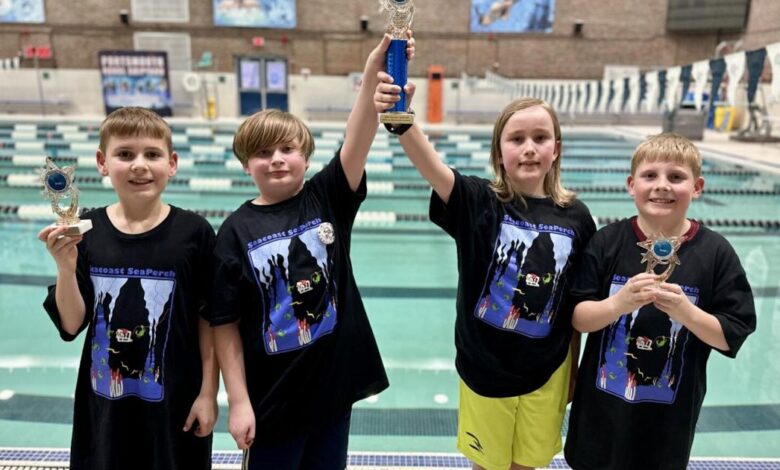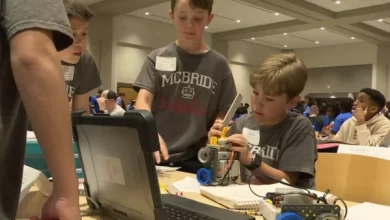Bronze Beasts robotics team to compete at International SeaPerch Challenge | News

CLAREMONT, N.H. — A group of Claremont area middle school students are putting their brains to the test as part of the Rogue Robots of 4-H, who built an underwater remote operating vehicle (ROV) that recently took first place at the UNH Regional SeaPerch competition.
Now the team has their eyes on big stage at the International SeaPerch Challenge at the University of Maryland this weekend. Their team, for this competition, is called The Bronze Beasts, named because they used bronze pieces along with PVC piping to build this particular ROV.
This year’s theme is deep-sea exploration, and the 2024 international challenge was inspired by information gathered by exploring geysers off the coast of Ecuador near the Galapagos Islands. According to the SeaPearch website, ROVs are necessary for researchers to use in areas that have extreme temperatures, pressures, toxic chemicals and reduced visibility.
The team consists of six local middle and elementary school aged students including: Claremont Middle Schoolers Lucas Tebo (eighth grade) and Owen Beaton (sixth grade); Bluff Elementary School students Willem Walker (fifth grade); Max DeLuca (third grade) and Owen DeLuca (fifth grade); and Thaddeus Martin who is a fifth grader being home schooled.
They have been working since January on building the ROV, and Martin expressed how much fun it has been while learning along the way.
“I like actually building it and experiencing it by driving it,” Martins said. “Competing with it is fun, too. We go from a pile of PVC and some parts, to growing into an actual robot.”
Jeff Proehl is the head coach and lead mentor and explained that there are two challenges for the Bronze Beasts to complete.
The first challenge involves five hoops that are 18 inches in diameter, spaced every four feet. The ROV needs to go through all five hoops, then surface the ROV and unwind the cable through the hoops as quickly as they can.
The second challenge involves two platforms, with one having a door that is opened to reveal a basket. The other platform has whiffle balls with weights in them, which are supposed to represent rock samples from the deep ocean. Three of the balls have loops on them, and the ROV needs to pick them up to transfer them to the bin. Another part of the challenge involves moving a cup to a pipe with bubbles coming out, take a sample, and have the cup rise to the top of the water.
“There are some other things, like pegs and a cylinder, they have to move,” Proehl said. “Each thing they move, they get points for what they have accomplished. You want the most amount of points in the least amount of time.”
He explained that there is a standard stock kit that can be used to make an ROV through Sea Perch, using three small motors that they control with a remote to go through the challenge courses. Together, the team has found what parts work well and how to tinker with design. For example, they adjusted two prong sections on the ROV so they can lift and move the balls efficiently when the ROV is in reverse. They also added lights to the ROV so they can see better underwater, as there are bubbles and ripples that can cause poor visibility.
“We 3-D modeled and printed everything on this ROV that you see here, except for the PVC,” Tebo explained. “The prongs on the bottom, we experimented with the tips. We used a single prong at the Regionals and switched to dual prongs to move the balls. With the double prongs it is easier to pick them up, and it also shortens the time.”
The competition involves one player manning the remote, and another feeding the cable attached to the ROV. The rest of the team will be behind them providing encouragement and strategic suggestions.
The underwater courses prove to be challenging and rely on plenty of team-wide brainstorming and trial and error, but the Bronze Beasts rose to the occasion with their win at the Regional Competition in April. In the hoops competition, where the team has eight minutes and two runs to navigate an ROV through a series of underwater circles, Martin was on the remote and posted a time of 1:37. The second fastest time at the competition was about 3:30, so they were clearly the top dogs of the Regionals. In practice, the team posted a time of 1:12. The Bronze Beasts placed third in the second challenge.
The top two teams from both categories were able to go to the international competition in Maryland, which included two elementary school teams and two high school teams. Rogue Robots- 4H also had a high school team that placed eighth at Regionals.
“We got the Obstacle Course Award, the Championship Award and the Design Award,” Owen DeLuca said.
Since their win at Regionals, the Bronze Beasts have been hard at work at the Claremont Savings Bank Community Center pool to practice each week. They also meet for a couple hours each week at their clubhouse to go over strategy, planning and use their scientific skills and knowledge together.
Proehl has been involved in this robotics program for about seven years, and said it is an excellent way to bring hands-on learning to these children in a fun way. He said without even realizing it, the students are learning about problem solving skills, engineering, density, melting points, magnetism and more.
“They are learning and not just getting it by sitting in a classroom” Proehl said. “And they seem like they are having a lot of fun.”
The team is amped up for the international competition this coming weekend.
“It is awesome to know that there are other people from around the world doing the exact same thing we are here in New Hampshire,” Tebo said.



